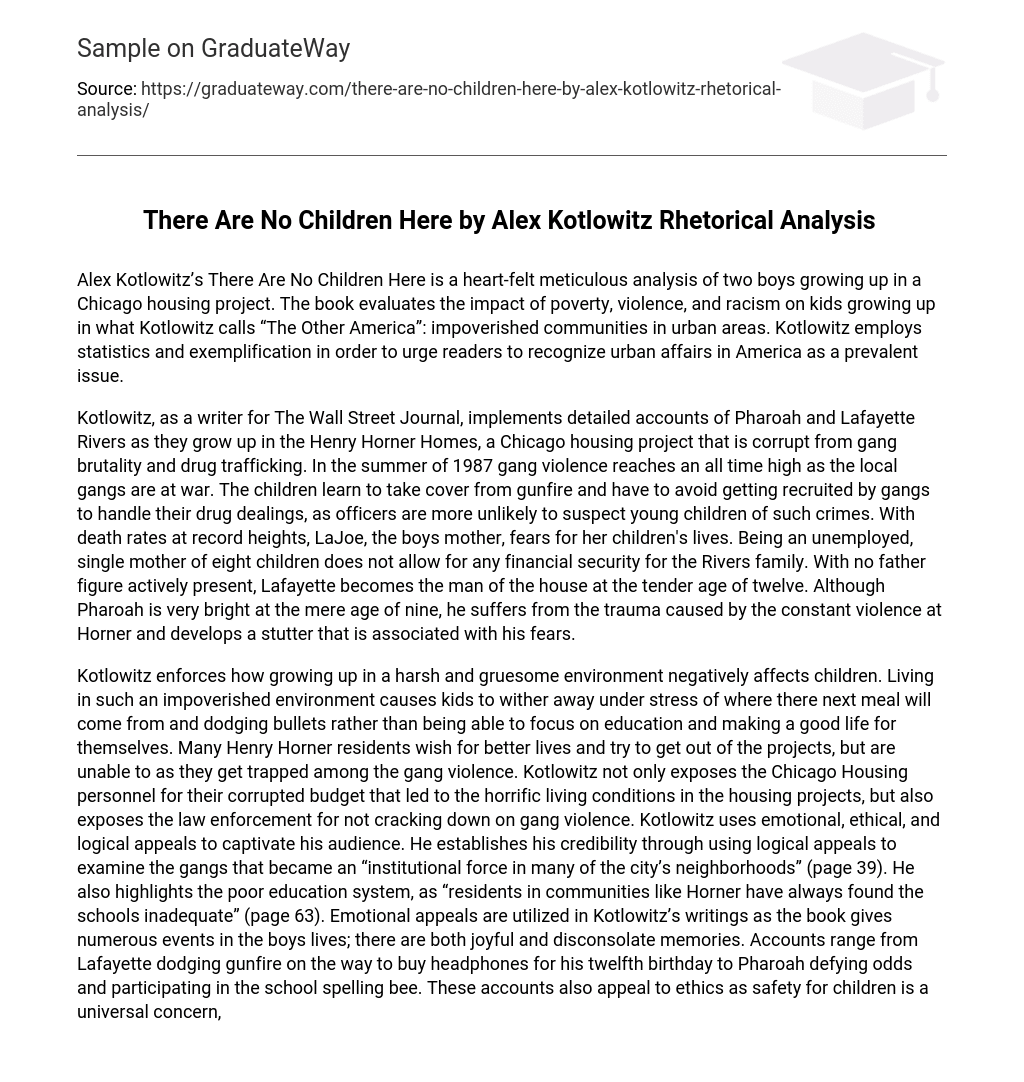Alex Kotlowitz’s There Are No Children Here is a heart-felt meticulous analysis of two boys growing up in a Chicago housing project. The book evaluates the impact of poverty, violence, and racism on kids growing up in what Kotlowitz calls “The Other America”: impoverished communities in urban areas. Kotlowitz employs statistics and exemplification in order to urge readers to recognize urban affairs in America as a prevalent issue.
Kotlowitz, as a writer for The Wall Street Journal, implements detailed accounts of Pharoah and Lafayette Rivers as they grow up in the Henry Horner Homes, a Chicago housing project that is corrupt from gang brutality and drug trafficking. In the summer of 1987 gang violence reaches an all time high as the local gangs are at war. The children learn to take cover from gunfire and have to avoid getting recruited by gangs to handle their drug dealings, as officers are more unlikely to suspect young children of such crimes. With death rates at record heights, LaJoe, the boys mother, fears for her children’s lives. Being an unemployed, single mother of eight children does not allow for any financial security for the Rivers family. With no father figure actively present, Lafayette becomes the man of the house at the tender age of twelve. Although Pharoah is very bright at the mere age of nine, he suffers from the trauma caused by the constant violence at Horner and develops a stutter that is associated with his fears.
Kotlowitz enforces how growing up in a harsh and gruesome environment negatively affects children. Living in such an impoverished environment causes kids to wither away under stress of where there next meal will come from and dodging bullets rather than being able to focus on education and making a good life for themselves. Many Henry Horner residents wish for better lives and try to get out of the projects, but are unable to as they get trapped among the gang violence. Kotlowitz not only exposes the Chicago Housing personnel for their corrupted budget that led to the horrific living conditions in the housing projects, but also exposes the law enforcement for not cracking down on gang violence. Kotlowitz uses emotional, ethical, and logical appeals to captivate his audience. He establishes his credibility through using logical appeals to examine the gangs that became an “institutional force in many of the city’s neighborhoods” (page 39). He also highlights the poor education system, as “residents in communities like Horner have always found the schools inadequate” (page 63). Emotional appeals are utilized in Kotlowitz’s writings as the book gives numerous events in the boys lives; there are both joyful and disconsolate memories. Accounts range from Lafayette dodging gunfire on the way to buy headphones for his twelfth birthday to Pharoah defying odds and participating in the school spelling bee. These accounts also appeal to ethics as safety for children is a universal concern, although at Horner it is not something that is taken into consideration, which Kotlowitz makes extremely clear.
The tone of the accounts of Lafayette and Pharoah’s lives during the Summer of 1987 is somber. Growing up in Horner has the children seeing a lifetime’s worth of horrors at a young age. Upon asking LaJoe Rivers permission to write a book about her children, she gave consent but also said, “but you know, there are no children here. They’ve seen too much to be children” (page xi). The children at Horner have seen so much of the bad in the world that they lose their innocent childlike mindset at a very young age. Kotlowitz utilizes statistics and a variety of sources to support his various claims on the urban affairs and social issues of Chicago. He puts an emphasis on the impecuniousness of the projects by referencing profiles from the Twenty-seventh Ward showing that over “46 percent of [Henry Horner residents are] below the poverty level.” (page 13). Though the facts used are all relevant and prove his writings reliable, it is through exemplification of the boys lives that entices the reader. By giving first hand accounts of numerous events that struck the Horner Homes, he evaluates in depth the despair that comes with living in a community that is so accustomed to crime and deprivation. At the root of all Horner’s problems are gangs. One boy known as Bird Leg became involved with the Vice Lords- one of the three local gangs- as a teenager. Because of his affiliation with a rival gang, he was shot on his way to visit some friends. Although extremely young, no one was shocked at his death, as one can “almost smell the arrival of death” at Henry Horner (pages 44-49). Death is as common as the busted out apartment windows at Horner, as displayed by the examples Kotlowitz gives. It is these terrifying stories that further alarm the reader of one of Kotlowitz’s main points: there is a lack of law enforcement in areas that need it the most. Though a highly pressing issue, the public turns its eyes away from these horrendous affairs as gang violence and poor education in poor areas does not directly affect them as it does the impoverished people that are consumed by their misfortunes.
Kotlowitz’s esteemed writing executes the telling of Lafayette and Pharoah growing up in the projects in Chicago through using emotional, ethical, and logical appeals to convey his message on the societal issues of Chicago in the late 1980s. Through using statistics and exemplification, Kotlowitz provides an intriguing account of two boys growing up in the “Other America”.





